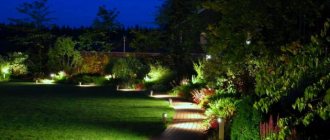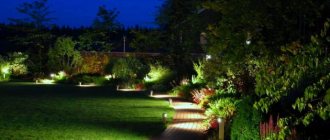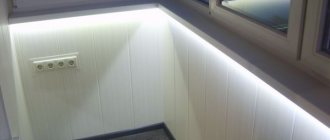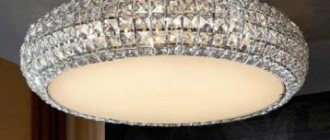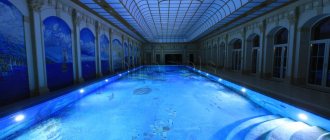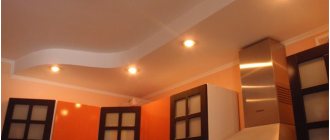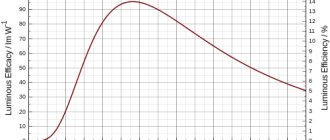Artificial lighting on the balcony allows you to expand its functional purpose. Thanks to lamps and lamps, it will be comfortable to be here at any time of the day.
Unfortunately, during the construction of the house it is not planned to lay electrical wiring into this room, so the solution to this issue falls entirely on the owner of the home.
Balcony lighting requirements
Due to the presence of a combination of unfavorable factors (differences in temperature conditions and high humidity), special requirements are imposed on installation work and the electrical wiring itself on the balcony:
- Only electrical appliances with a high degree of dust and moisture protection are allowed for use. This parameter is indicated by the letters IP and numbers after them. Completely sealed electrical appliances are marked IP68. The lower the number, the less resistance to external influences.
- Before installing electrical wiring, care must be taken to maintain a stable level of humidity in the room and good ventilation. If the level of these parameters is elevated, this may cause a short circuit.
- For an unglazed balcony, it is better to use lamps without wiring. In exceptional cases, it is possible to lay the wire in a protective box, and use only waterproof lamps.
- The type of lamps used directly depends on the temperature in the room. For example, at low temperatures it is not recommended to use fluorescent lamps.
- On unheated balconies and loggias there must be a minimum number of wiring cable connection points. Therefore, the best location for the distribution box is in a heated room.
- A small balcony requires lighting fixtures that are compact in size. Large lamps and floor lamps will “eat up” valuable centimeters of space.
- All installed electrical appliances should not interfere with free movement on the balcony. Accidentally touching a lamp or plug in an outlet can result in electrical injury.
- Each area on the balcony requires its own lighting scheme. This point must be taken into account at the wiring stage.
Types of lamps for an enclosed balcony
When choosing lighting fixtures, you should pay attention not only to the design and design, but also to the category of light sources.
Wall lights
It is used exclusively for illuminating individual areas, for example, a work area. These could be sconces and floor lamps.
Ceiling lamp
It looks like a lamp in a lampshade under the ceiling or a chandelier on a wire. Used for local, accent or general lighting.
You can use spot light. It is a whole system of lighting sources, consisting of lamps, wiring and transformers.
Mounted in a suspended or suspended ceiling. Used for general or local lighting.
Desk lamp
Gives soft but targeted light. Used for zoning a room.
Fluorescent lamps
Such lighting is mounted in the ceiling space or on the walls.
The power of daylight lamps can be selected depending on the volume of the balcony room.
LEDs
Cannot serve as general lighting due to low power. Used for decorative lighting and creating compositions.
Open balcony lighting
The main difference between an open balcony and a glazed one is the presence of an aggressive environment and regular exposure to weather factors.
All this must be taken into account when choosing lighting fixtures and wiring elements.
On an open balcony, it is permissible to install only light devices in a sealed housing.
If it is expected that raindrops or snow will fall on it, then the degree of protection should be maximum.
When lighting on loggias and balconies with a canopy, the use of devices with a degree of protection not lower than IP44 is allowed.
Chandelier or spotlights: how to choose
Since a loggia or balcony usually has a small area, when creating a lighting system you have to carefully save space. Therefore, preference is often given to spotlights of the spotlight type. But each of these solutions has its pros and cons.
dimensions
A chandelier usually hangs from the ceiling. This option is suitable only for owners of spacious loggias, where you can walk calmly without fear of hitting the lamp with your head or even shoulder. If you don’t have a lot of space, it is better to prefer a flat chandelier “pressed” to the ceiling - or install spotlights.
Lighting area
It is clear that the larger the area of the balcony or loggia, the higher the illumination should be. Unfortunately, the lighting standards for balconies are not regulated by any standards. Therefore, you can only approximately determine how many light bulbs you will need.
If there is a chandelier, then most likely there is one, in the center of the ceiling. It may have three or four light bulbs.
Spotlights should be distributed over the entire surface of the ceiling. For a standard balcony, three or four pieces are enough, the power of each of them depends on which lamps you choose. If, for example, halogen, then 20- or 30-watt lamps are suitable.
Style
Spotlights are hidden in a false ceiling and are therefore well suited for balconies decorated in the spirit of functionalism or hi-tech or in the Scandinavian style.
The chandelier is another matter. It’s hard not to notice, so if you want your balcony to look especially interesting, you need to think about how it will fit into the interior.
A small balcony or loggia can be decorated in a classic style. Provence, oriental aesthetics or modern are also suitable for them. For a spacious loggia, you can choose an interior and, accordingly, a chandelier even in the Baroque style.
Lighting on the balcony in accordance with its zoning
When zoning a room, first of all, large elements of furniture are selected, and then lighting fixtures.
Some rules for lighting individual functional areas:
- A good option for a work area is a ceiling spotlight with diffused flux. For individual lighting, a table lamp with a movable (rotating) leg is suitable. An option if there is no outlet is a USB lamp.
- When organizing a greenhouse, primary attention should be paid to the needs of the plants. Regular lamps are not suitable for this, only phyto lamps with rays of a certain spectrum. For basic lighting, you can use a ceiling fluorescent lamp.
- The lounge area offers a relaxed atmosphere and dim lighting. This effect can be achieved using a floor lamp, several wall sconces, table lamps and electric candles.
- For a pantry, dressing room or mini-gym, good lighting is important. Spotlights with maximum power and complemented with LED strip are suitable.
Artificial light sources are used not only to maintain the style of the room, but also to visualize the boundaries of several zones.
Directional light lamps cope best with this task.
Design project: Int2Architecture
Tips for lighting
When organizing lighting in a loggia or on a balcony, it is recommended to adhere to a number of rules:
- On an open balcony, it is best to install wall lighting. It is advisable to place the switch inside the apartment. There should only be a wire outside.
- For open balconies, you should purchase only lamps that are protected from moisture.
- For balconies that are used as resting places, spotlights or sconces are suitable.
- If they will read on the balcony or use it as an office, it is advisable to install turn signals so that the function of regulating the flow of light appears. It is also possible to install additional lamps in places where light is especially needed.
- It is recommended to organize local lighting in cabinets. This approach will allow you to quickly find the items you need. The best illumination is achieved using LED strip.
- It is not advisable to install light diodes opposite glass, since in this case glare on a computer monitor or television screen cannot be avoided.
- If the balcony after renovation is actually a single whole with the neighboring room, any type of lamps will do. However, in this case it is recommended to maintain the general style of lighting fixtures.
It is not difficult to install lighting on a balcony if you strictly adhere to technical standards and safety rules. If you don’t want to deal with wiring or disturb the finish, it is recommended to opt for autonomous LED lighting.
What to look for when choosing lighting
Device type
It must be protected from dust and moisture. It is better to place the switch inside the apartment.
If the balcony is dry and heated, then the choice of device is made based on its purpose: for a desktop, for general lighting, for decor and accents.
Balcony style
The main requirement is compliance with the general style. For minimalism, spotlights, laconic chandeliers and sconces decorated with chrome and matte elements are suitable.
For the loft - any metal lampshades. For a balcony in neoclassical and modern style - extraordinary models made of transparent glass.
The retro-style room will be complemented by floor lamps with fabric lampshades and lanterns, stylized as street options.
Design project: MARION STUDIO
Room size
On a small balcony, every centimeter is important, so the size of the lamps should be modest.
With low ceilings, hanging chandeliers, voluminous floor lamps and sconces with rich finishes and decor are unacceptable.
And vice versa, the larger the area, the more massive the light sources should be.
Design project in the Fili Grad residential complex
Original DIY lamp
It’s easy to buy a ready-made lamp - hundreds of manufacturers annually produce collections in a wide variety of styles. But making a beautiful, practical thing with your own hands is much more difficult. But the result will be a wonderful reason for pride and a great accessory for decoration.
Model to execute
Table lamp with a stand made of old books and a false lampshade made of a metal frame. A hand-made lamp for a balcony looks a little unusual, but it is ideal for a room in a loft, Provence, or country style.
An original option for paper lovers
For work you will need the following items, materials, tools:
- a stack of old, but not disheveled books;
- a metal frame from a lampshade with a base (you can make it yourself);
- electrical power cord with plug;
- spray paint for metal;
- measuring instrument – ruler, tape measure, marker;
- drill;
- construction knife.
Task
Secure a stack of books with a pin inserted through it; pass the power cable through the entire stack to the base attached to the top.
- We start by painting the metal parts. Without exception, we coat all elements with corrosion protection and then paint them in the desired color.
“Metallic” colors are suitable for painting: gold, silver, bronze, copper
- We collect books in a stack so that it looks natural. The height should be the same as the holder pin through which the power cable will pass.
Unneeded books can be purchased at a thrift store
- Approximately in the center of each book we place a dot - there will be a hole for the central pin.
To drill holes, use a drill with a drill whose diameter matches the diameter of the pin
- In the book lying below, in addition to the hole for the pin, you will need a groove to lay the wire.
A construction or stationery knife is suitable for cutting a groove.
- The bottom book is the base; it is necessary to attach a pin – a holder – to it.
We use union nuts as fasteners (to increase the connection density)
- We insert an electrical wire with a plug into the pin, and remove the bare ends from the upper hole.
We fix the metal part on the bottom book-base
- Then we drill holes in the remaining books. We try to drill in the center.
Hold the book with your hand or with special clamps
- We string the books into a stack, turning them slightly around the circumference so that the stack turns out natural, slightly careless.
For stability, we fasten the books together with long self-tapping screws.
- We connect the wires to the base. Screw in the light bulb. A beautiful antique table lamp is ready.
If desired, you can put a lampshade made of fabric, beads, lace or thick paper on the frame, but even in this form it looks very stylish.
Types of lamps
Incandescent lamps
Cheap, accessible, but outdated and short-lived option (up to 1000 hours of operation). They consume a lot of electricity.
Halogen
With the same power as incandescent lamps, these consume half as much electricity.
A variety of shapes and shades of light allows you to choose a halogen lamp to suit any interior.
LED
Modern, economical and durable option. Service life – up to 50,000 hours.
Organization of power supply
As a rule, there are no electrical outlet points on the balcony, so you will have to organize them yourself.
Design project: studio Simple Interiors by Lesya Pechenkina
Three implementation options are available:
- From the shield on the landing. This method allows you to make the power supply to the balcony completely autonomous (with its own automatic machine). Devices of any power can be connected to the network. But it is possible to install such wiring only at the stage of major repairs.
- From the distribution box in the room adjacent to the balcony. Convenient and easy to implement method. The only negative is that you need precise control of the permissible load.
- From the nearest outlet. A simple method that allows you to connect one or two low-power lamps.
Design project: Irina Ezhova and Olesya Zlobina
It is necessary to agree in advance with the electrician on all the desired electrical appliances so that the technician can correctly calculate the wire cross-section based on the maximum load.
How to provide lighting without electricity
Many people are interested in saving energy and using the planet's resources wisely. Let's consider two ways to make lighting without connecting the device to the electrical network. The first way is to use solar-powered balcony lights.
A small solar panel positioned at the right angle to the sun
The technology of the device is simple: instead of some glass, solar panels are installed - flat panels that convert solar energy into electrical energy. During the day, the accumulated heat serves as a reserve for evening lighting of a small area. Sometimes there is enough energy to recharge a mobile phone or laptop.
The second option is stationary battery-powered LED flashlights. They are hung from the wall or ceiling, and when leaving, they are removed or simply turned off. Such flashlights are intended for use in rooms where there is no electrical wiring - in caissons, outdoor toilets, in summer gazebos, on terraces.
Wiring
Several recommendations for installing wiring on a balcony or loggia:
- In the absence of experience and knowledge, all work with electricity must be entrusted to professionals. Including preliminary calculations and selection of materials.
- Installation of lighting elements on the balcony does not require approval. However, if redevelopment is needed for zoning the premises, then it must be legalized.
- For wiring, only double insulated cables are used. In an open or unheated room, it must be placed in a corrugated tube.
- Wiring is the first stage of balcony repair. Only after its completion can you begin insulation and cladding.
- To accurately calculate the number of sockets and lamps, it is necessary to determine in advance the functional purpose of the room and draw on the walls a diagram of the future wiring with all the elements.
- Open wiring is easier to install than hidden wiring, but it is unsafe and looks less aesthetically pleasing. One way to hide it is to cover the walls with clapboard or panels.
Design project: Azari Architects
How to connect the light yourself
You can do the wiring yourself or ask a professional for help. It all depends on the design method. There are companies that are able to do the installation work the way you want it, give some advice on decorating your balcony, and also select the right devices.
First you need to determine the functional orientation of the room. Afterwards, a wiring system is installed to connect electricity. To create lighting, you need to solve the issue of fire safety. If you are a beginner and don’t understand electrics at all, it is better to entrust this task to professionals, because doing it yourself is dangerous.
Note! Sometimes you have to do major repairs on the balcony - redo the walls, ceiling, floor. This is a good opportunity to create hidden wiring.
Electrical installation on the balcony
To create lighting you will need the following:
- Hammer. Its purpose is to create grooves for wires.
- Drill. If you need to make through holes for cables
- Screwdrivers and pliers.
- Switches with sockets.
- Cables, as well as brackets to secure them.
- Tester and phase indicator. This will help determine the voltage.
- Distribution boxes and insulator.
- The light source itself.
Now let's start creating the wiring:
- We start with preparation. We determine where exactly the wiring needs to be done. If you make the wrong choice, you can ruin the design of the room. Using a marker, mark the direction of the cable. Also on the surface of the walls you need to make marks of the places where sockets with switches will be installed, as well as a lighting fixture.
- We take a hammer drill and make grooves for the cable. It is best to use simple diagrams.
- Now let's start laying the wires. First we place the cable in an insulator. Then we apply it in the groove.
- We carry out the wiring to the power source. We fix it on the dividing box. We carry out isolation. We connect the wires and cover the box with alabaster. It's the same with strobes.
- After the alabaster has completely dried, you can begin installing the socket and switches.
- And the last step is the installation of lighting fixtures. The amount of light on the balcony will depend on their number. To begin with, we select those lamps that are suitable for our room - if the loggia is insulated, then that’s it, if not, we need a frame. Installation of lighting fixtures is carried out using screws and self-tapping screws. You need to make holes in the wall using a drill. The weight and structure of the lamp are taken into account.
The nuances of creating wiring
It is important to follow safety rules when carrying out.
An example of how to install light on a balcony from an outlet using hidden wiring
We recommend the following:
- use only copper wires;
- install layers of insulation on the wires;
- It is important that the wire matches the number of cores. The cross section is taken into account.
Installation of lamps
When the wiring is installed and all the outlet points for electrical appliances are created by professionals, installing a suitable lamp yourself will not be difficult.
To do this you need:
- Turn off the power to the wire you will be working with.
- Prepare a place to mount a lampshade, chandelier or spotlight. This will require drilling holes into the concrete or clearing space on the sheathing.
- Place the lighting fixture and secure it according to its instructions.
- Insert the power wires into the inlet hole and secure them to the socket.
- Screw the lamp into the socket and check its functionality.
- Reinstall the lampshade.
Choosing a location for an outlet
The location of the outlet should be convenient and accessible. It is important to organize it so that the plug of the electrical appliance can be connected to it without difficulty.
The external wall under the window is not used to place the outlet. It is durable and making a hole in it is difficult.
Best places for installation:
- From the ends of the balcony.
- In the outer skin.
Design project: Aiya Design
To ensure that the placement of the socket is as inconspicuous as possible, you should not use a balcony door to bring out the power wire.
No. 2. In what order should the work be performed?
If all the work on supplying electricity to the balcony and lighting it is carried out independently, then you should adhere to a clear action plan . It is approximately the same for all the options described above and is as follows :
- power outage in the apartment;
- calculation and preparation of the required amount of cable;
- marking walls for further gating;
- creating grooves from the connection point to future sockets, switches and installation locations for lamps. They are made using a wall chaser or chisel. Since the cable is routed to the balcony through the wall, you will need to make a hole in it with a hammer drill;
- place the cable in the grooves and secure it with alabaster every 20 cm, it sets very quickly;
- connect the elements into one circuit;
- ring with a multimeter and seal the grooves with a solution;
- connect to the circuit breaker at the input.
Do not forget that all lighting lines must be protected from moisture, which may be present on the balcony, even if it is glazed. It is better to select copper wires with a cross-section of 1.5 mm2 and connect them with terminals rather than twisting them.
Balcony lighting without wiring
If for a number of reasons wiring installation is impossible, you will be able to do without it. When using battery-powered light sources, there is no need to drill into walls or pull wires.
In high-quality lamps, three batteries are enough for continuous operation for 100 hours.
All you need:
- Sources of light.
- Batteries for them.
- Charger.
- Motion sensors (optional).
When choosing, you should give preference to those lamps in which access to the battery compartment always remains free, since the batteries will have to be changed.
For this reason, lamps on double-sided tape with a compartment on the back are not suitable.
Lighting on the loggia and balcony are integral companions of a cozy and comfortable room.
Chandeliers, floor lamps, spotlights and sconces will help you create it.


